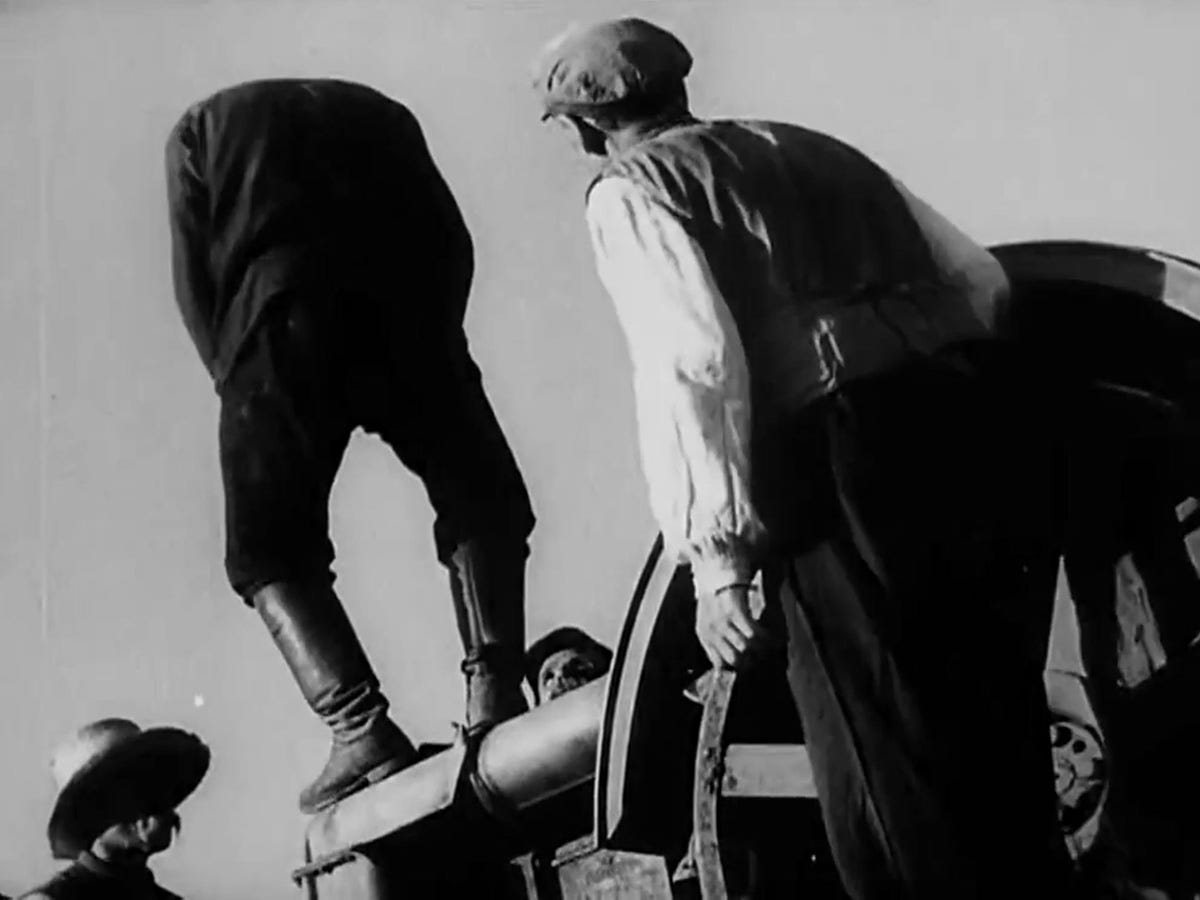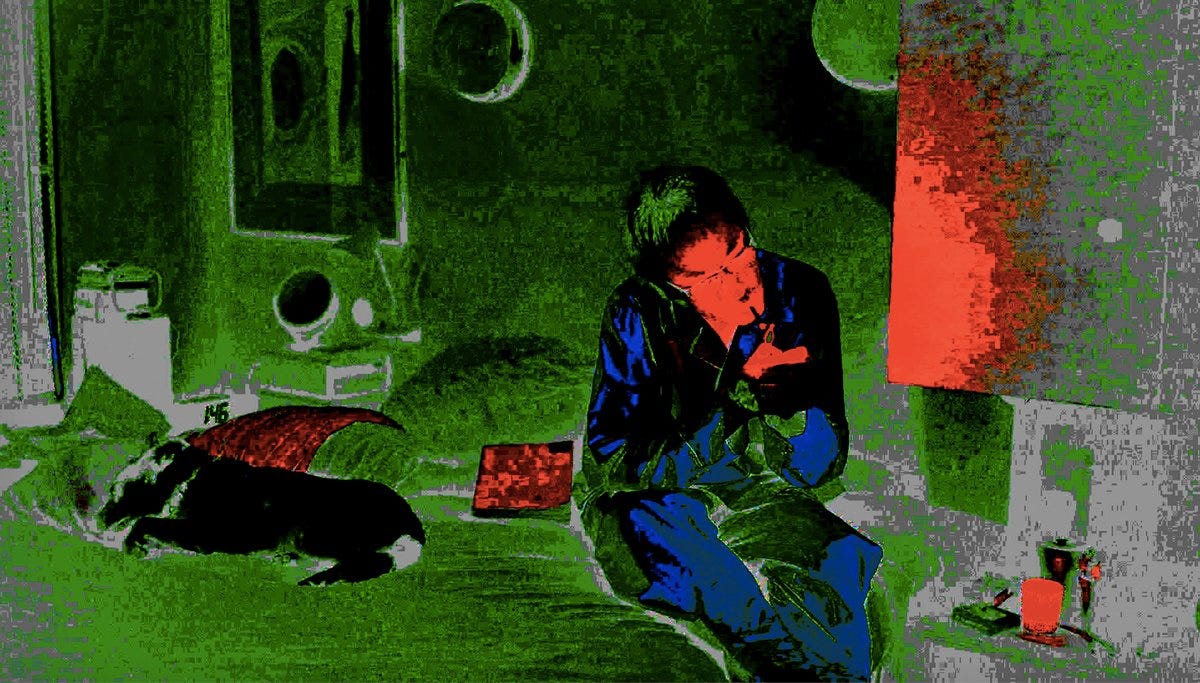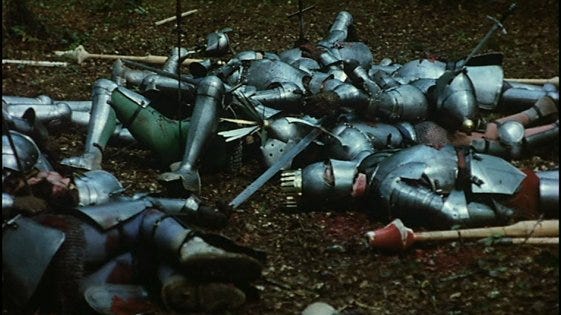Drinking at a bar downstream of Anthology Film Archives; it’s Sunday, the weather is still pretty good. The bar is all Edward Hopper redux; a troupe of lushes, backs to the world, wine-beer-whatever they’re talking (improbably) about New York in the 70s, oysters, an old-timey music venue somewhere. I notice an air of gregariousness; the word lands there. I’m sitting outside with Gerald Murnane’s Inland flipped over on the table and there’s a couple sitting in front of me. I think they’re a couple; lapsed into silence, eyes cast down into their phones. I can’t say whether this heralds the decline of gregariousness. Somewhere, on the other side of the city, there is a screening that might be considered a late ur-text for the so-called “downtown scene”, and I looked at photos of it, later—of the screening—on Instagram, and performed a kind of mute shrug. I can’t say if this heralds the decline of gregariousness. Some days later, I’ll sink five martinis a plate of oysters and think I’m really on form, even if I got lost on the way back to my hotel. I can’t say if this, etc.
Later, at Anthology Film Archives, I watched Dovzhenko’s Earth (1930) with my printed out script; worn and faded on manilla paper. Realized I couldn’t actually read the script in the heavy darkness. I focused on Dovzhenko’s compositions—his angular heroics—and realized how funny some of them are. He has a lot of fun in match-cutting between peasants—slouch shouldered, clench-jawed—and cattle, which are really made up to seem very heroic-looking. It’s a sly little joke; Dovzhenko doesn’t hold them in contempt. He’s saying: the peasants and their cattle are part of the same system. He does the same thing when he shows the peasants marching beneath a row of telephone masts, stretching courageously into the horizon—a great mass of sky and cloud above. Telephone masts and straight-backed peasants. I think he’s funny in the way that James Benning is funny; at least when it comes to landscape.
There are flourishes of the Dovzhenko of Arsenal, which he’d made in 1929—a year earlier; the propulsive-convulsive montage of clashes and collisions. The film’s strongest sequence is the most documentary; we get (1) tractor plowing field; (2) women gathering bushels of wheat; (3) threshing machines; (4) the industrial mixing of dough; (5) the mechanical shaping of raw loaves; (6) great trolleys of dark, baked bread. There are machines and there are hands. I waited for a friend outside the cinema and some guys, who were in the screening, were chatting amiably about it; one of them called the threshing scene “molecular”, and I think that is quite accurate. Dovzhenko gets us really close to the surface of the threshing machine; wood gyrates in one direction (it is an angular-flat plane) and specks of wheat rhythm and bounce across it; the image pulls itself apart, becoming abstract. Dovzhenko is a scientist and he is a pastoralist. He’s saying that we have nothing to fear from the machine; this is exactly the right kind of perspective you’d expect from a revolutionary filmmaker; bringing his big heap of camera equipment with him to the Ukrainian countryside, flashing it around. He also gets weird with it; the film’s final act was politically unpopular. It is actually very strange, and it was good to see this film in the Anthology Film Archives and to pick up a programme (September-October 2024), which I think I’ll treasure for a long time. Dovzhenko was censored by the Soviet authorities for Earth; particularly the film’s final wurlitzer-seeming act—a stomping-mad kulak, pitiful priest falling to his knees, woman giving birth, another woman—in grief—tearing her clothes off, literally squeezing her body. This all happens in silence; you’re aware of a wall of polyphonic cacophony sort of thrumming behind it all. When I used the AFA bathrooms, I wondered if Stan Brakhage had ever stood at these urinals—or Jonas Mekas. No way of knowing this for certain.
Later, another day later, I caught Leos Carax’s new manifesto-film at the Lincoln center: It’s Not Me (2024). He was supposed to make an appearance, I think, but didn’t, and the programmer of NYFF made some vague explanation as to why but I must have misunderstood or wasn’t listening properly because I can’t actually recall the reason, now. We were directed, instead, to watch an interview he’d recorded for them, explaining that we could find it online. I thought, ok, I’m not going to watch that. The film itself has been described by Carax as a “cut-up”; I don’t know if this is useful or helpful to know.
The film actually felt like a kind of Godard pastiche; a facsimile of Godard’s late essay films — The Image Book (2018), Goodbye to Language (2014), Film Socialisme (2010). Carax has the same gravelly voice and blocky intertitles—using Godard’s red, white, green, and black; he uses hypersaturated imagery and heat-sensor photography (hello Harmony Korine), remixing them with bits of archival photography. Unlike Godard, Carax isn’t here to interrogate “the image”; and he’s not trying to exhaust images of meaning. He’s not doing that Godardian thing of smashing and decaying his photography. It’s prettier; more in hock to a formalized idea of beauty. Despite this—the sense of hollowness—it is quite good; it does what it’s supposed to do (advertise Carax as “brand”, reify a particular idea of cinematic genius and romanticism). Godard says: I do not know what the image says, but I know it’s doing things; Carax says: I know what the cinema means to me. Yet, it is quite moving; I enjoyed it. It showed me “new” images; it created “new” images. I enjoyed it and then left, queued for the toilets, went out into the late afternoon sun. I ate a heavy meal in a Parisian-style bistro and drank a martini and then walked somnambulistically through Manhattan, stopping in a bookstore to try and find a copy of Robert Coover, seeing as he’d died a few days earlier. I couldn’t find anything. When I got home, I watched a bit of that Nam June Paik documentary on MUBI but I was really too tired to latch on to it, tapping out after fifteen minutes or so. I later watched the rest of it—when I got back to London—and thought it was quite charming, and it made me immediately miss New York, where Paik made his home, in a way I found surprising.
Later, I found time for another film; scouring for something proper at Film Forum. It’s amazing how, in New York, you don’t want for repertory cinemas. There’s so many of them; it’s one of the things I like most about New York. Actually the Film Forum website was out of order or I was being stupid, so I couldn’t actually buy a ticket; the person on the phone said, uhh, there’s still ninety tickets left, you’ll be fine. When I got there—and paid for my actual-paper ticket—I idled for a while in the lobby and smiled when I saw the Jacques Derrida banana bread and took the obligatory photo of it but didn’t want, in that moment, to eat the Jacques Derrida banana bread, so I ordered a diet coke with a lot of ice and then sat down for Bresson’s Lancelot du Lac (1974). There were only a handful of people in the cinema.
It’s the Bresson I haven’t seen; a colour film shot in his “late” phase, when his earlier melancholic trembling has been swapped out for coiled iconoclasm and high-principledness. I have always loved L’argent (1983) and Le Diable probabalement (1977), and Lancelot du Lac fits “neatly” into their language and ideas. It is a medieval fantasy stripped of all but the most elementary of signifiers. It is not John Boorman’s Excalibur; I kept thinking about the differences between them. Bresson probably didn’t even know how to turn on a smoke machine, let alone know which way to point it. Film is a broad church, I guess.
Lancelot du Lac—it’s been restored in 4k—is murky and swampy, for all its formal tightness; the trees of the forest are like dark, soiled bands that break that frame into vertical slices that also stew the spaces between those slices into myopic ambiguity. Bresson uses a lot of spurting red blood; and the fighting between armoured knights is propulsive but also mechanical, as sudden and unexpected as it is fatal and emotionless. Blood pours everywhere and horse-eyes roll and faces remain all but frozen. Bresson’s actors—his “mannequins”, which is how he liked to refer to his actors—deliver their lines as impassively as possible, articulating them with the inevitability of an already passed-over legend. But, despite this, there remains a sump of emotion; by sucking away the big theatrics of death and desire, Bresson draws attention to their lack. It leaves a lot of space for us to see what is “really” going on; it is mercurial and really quite mad, in its own way: I mean that in the sense of its logic of illogic: motivations don’t really make sense, there’s disorder, allegiances shift and slither around, we don’t know who stands for what or really what anything “means”. In his late films, Bresson was increasingly concerned with the rueful disintegration of western civilization; the yoke of money, political violence, anomie, purposelessness. With Lancelot du Lac, he projects these archly contemporary concerns back into the spiffy past of Arthurian legend; draining it of its code of honour, where even the binary between “good” and “evil” is chucked out. By the film’s end—and this is not really a spoiler—basically everyone is dead; a tangle of blood-spattered bodies—we can’t see their faces—into which Lancelot, the last man standing, exaggeratedly, dying, pirouettes. The lake is the lake of blood; it is a disheveled water that only spreads the blood further. There are no dragons, no wyrms, no wizards, no arms thrusting swords from sacred lakes; there is just frayed purposelessness and disorder masquerading as something they’re not. It’s all bitingly cynical—and strangely alive.
So there you have it; some films I watched in New York. It’s always a good idea to spend a few hours—when you’re in a different city—inside a cinema.
If you liked this newsletter then please consider liking, sharing or subscribing. It’s lonely here.









